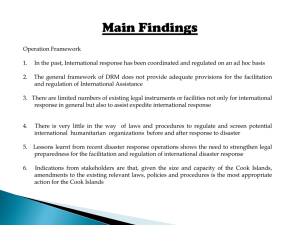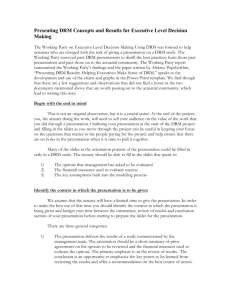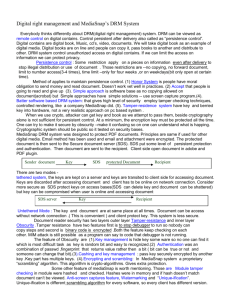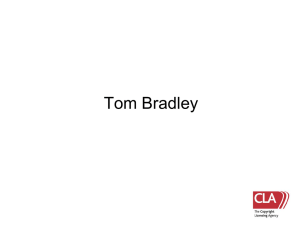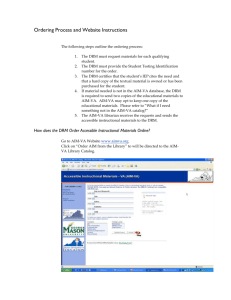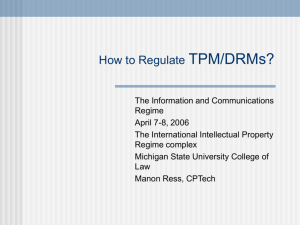"European Copyright Revisited" Santiago de Compostela, 16 - 18 June, 2002
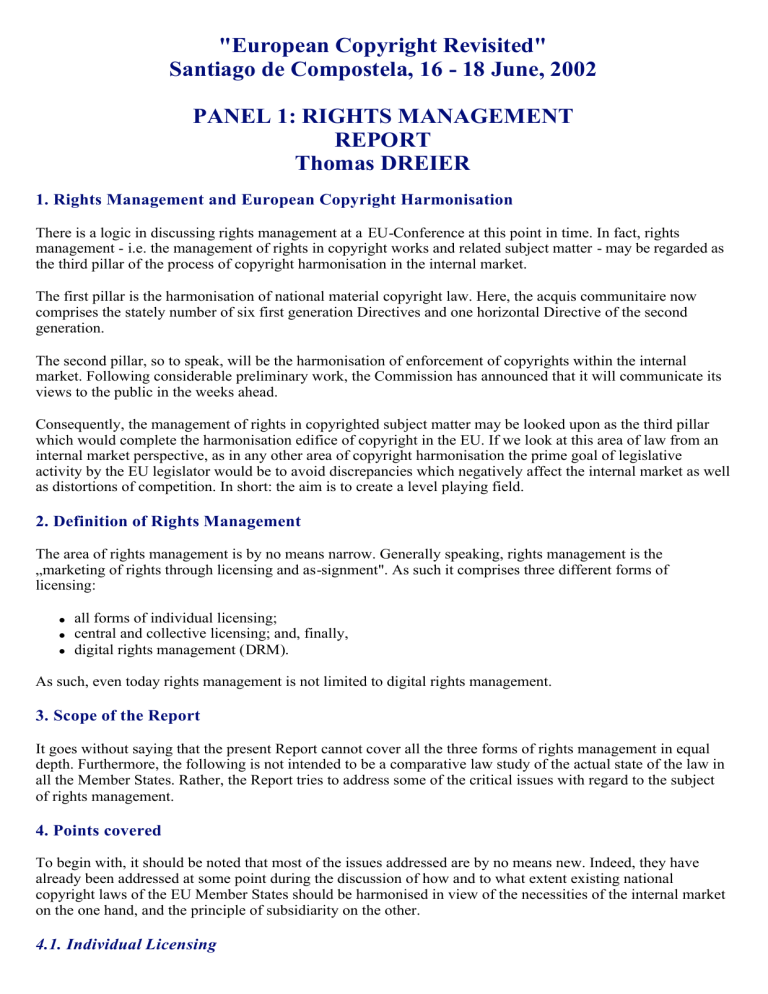
"European Copyright Revisited"
Santiago de Compostela, 16 - 18 June, 2002
PANEL 1: RIGHTS MANAGEMENT
REPORT
Thomas DREIER
1. Rights Management and European Copyright Harmonisation
There is a logic in discussing rights management at a EU-Conference at this point in time. In fact, rights management - i.e. the management of rights in copyright works and related subject matter - may be regarded as the third pillar of the process of copyright harmonisation in the internal market.
The first pillar is the harmonisation of national material copyright law. Here, the acquis communitaire now comprises the stately number of six first generation Directives and one horizontal Directive of the second generation.
The second pillar, so to speak, will be the harmonisation of enforcement of copyrights within the internal market. Following considerable preliminary work, the Commission has announced that it will communicate its views to the public in the weeks ahead.
Consequently, the management of rights in copyrighted subject matter may be looked upon as the third pillar which would complete the harmonisation edifice of copyright in the EU. If we look at this area of law from an internal market perspective, as in any other area of copyright harmonisation the prime goal of legislative activity by the EU legislator would be to avoid discrepancies which negatively affect the internal market as well as distortions of competition. In short: the aim is to create a level playing field.
2. Definition of Rights Management
The area of rights management is by no means narrow. Generally speaking, rights management is the
„marketing of rights through licensing and as-signment". As such it comprises three different forms of licensing: l l l all forms of individual licensing; central and collective licensing; and, finally, digital rights management (DRM).
As such, even today rights management is not limited to digital rights management.
3. Scope of the Report
It goes without saying that the present Report cannot cover all the three forms of rights management in equal depth. Furthermore, the following is not intended to be a comparative law study of the actual state of the law in all the Member States. Rather, the Report tries to address some of the critical issues with regard to the subject of rights management.
4. Points covered
To begin with, it should be noted that most of the issues addressed are by no means new. Indeed, they have already been addressed at some point during the discussion of how and to what extent existing national copyright laws of the EU Member States should be harmonised in view of the necessities of the internal market on the one hand, and the principle of subsidiarity on the other.
4.1. Individual Licensing
According to fundamental legal principles adhered to by all EU Member States, individual licensing of rights in copyrighted subject matter - as in any other subjective rights - is the form of rights manage-ment which requires, and indeed allows for, the least intervention by the legislator. The assumption underlying this legal principle is that private parties act on their free will, and that this will should prevail as long as exercising it does not violate any rights - as opposed to mere interests - of third parties. Hence, we rarely see royalty rates fixed by law; such prescribed remuneration is the exception rather than the rule. Similarly, most copyright contract rules are default rules from which the parties to an individual contract can derogate, rather than unwaivable binding rules. From this point of view, corrections only seem justified in order to rescind outrageous contracts or declare void certain contractual obligations, and to protect the structurally weaker party to the contracts. This holds true equally for national legislators and the EU-legislator.
Hence, in general, the EU might interfere with regard to the legal framework for standard terms and conditions; to keep the copyright system in balance especially regarding questions of abusively low remuneration and overly broad transfers of rights; and to safeguard certain user rights which should not be curtailed by way of contract (indeed, quite number of Directives contain provisions of the latter type). Interfere, it should be added, insofar as such interference can in fact be based on a Treaty norm which grants the EU the legal competence to do so (which shall not be examined here in further detail).
However, as the recent German experience of enacting special copyright contract rules in order to secure to authors the payment of an adequate participation in the proceeds of the exploitation of their works has demonstrated, it is very difficult, if not impossible, to reconcile the interests of flesh-and-blood creators and performers with those of profit-oriented media enterprises and both of these with the interests of users. This seems all the more true in view of the diverging contract „cultures" in the anglo -saxon and the continental world.
4.2. Central and Collective Licensing
Collective licensing is another form of rights management which is well established in the analog field. The advantage and the benefit of collective licensing is that it facilitates transactions with regard to rights in copyrighted subject matter for both authors and users. The downside of collective licensing is that it almost invariably leads to monopoly situations, since from the user's perspective, collective licensing of certain works tends to considerably narrow, if not eliminate, competition through substi -tutable works. Furthermore, the relationship between collecting societies and their members, or those who have their rights licensed via collecting societies, is likewise not free from antitrust concerns. These aspects all call for legal rules which create at least a minimum frame-work for the collective exercise of rights, as it already exists in many EU-
Member States. In view of the discrepancies of these national rules, however, the EU might feel called upon to harmonize in this area in order to create a level playing field, and provide more detailed guidelines than there are at present by way of the case law handed down by the ECJ.
In this regard, one point merits special attention: if legislative action is taken at the EU-level regarding collective licensing, such action should be initiated by the copyright experts rather than by the antitrust division. The reason for this is relatively simple: due to the nature of rights in copyrighted subject matter, collective licensing is in many respects different from collaborative behaviour in other market sectors and with regard to other goods and services. True, collective licensing should be guided by a framework inspired by competition law concerns, but this framework should be tailored to the particularities of copyrighted works and the special needs of authors, rightholders, commercial and non-commercial end-users alike.
In addition, it is well known that so far it was not possible to achieve harmonsation regarding the question of how to deal within the EU with legal licenses and claims for remuneration. In some countries, such as
Germany, these remuneration claims are exclusively administered by collecting societies. Hence, there is a link between remuneration claims and collective licensing (although the rationale is different from collectively licensing exclusive rights). There is also a link between remu -neration claims and digital rights management (as will be discussed below). Past experience with copyright harmonisation has demonstrated that these difficulties are unlikely to be easily overcome. This is all the more true since little is known so far about the relationship between such legal licenses and digital rights management.
Therefore, for the time being the focus with regard to collective and central licensing should lie on the role to be assumed by collective and central licensing in the digital and networked environment. Here, it is often
argued that collective licensing will become obsolete to the extent that in the analog field collective licensing has solely been based on market failure, and provided this market failure is eliminated by digital and networking technology. However, one should not forget that in the analog field, in many cases collective administration is not only an answer to market failure, but serves other purposes as well. In addition, digital and networking technologies may eliminate some of the market failure but they don't always reduce all transaction costs to zero. Furthermore, existing collecting societies certainly have the means at their disposal to organise new forms of centralised licensing. This could lead to "one-stop-shop"-licensing, which is so often called for by the users' side. In sum, in my view, forms of collective and/or central licensing will play a vital role in the digital and networked environment.
4.3. Digital Rights Management (DRM)
Digital rights management (DRM) comprises the use of all "technical tools, which are designed to prevent acts of exploitation of IP rights by way of controlling and managing access". These tools "mainly concern copy control systems, which control access and/or manage rights through devices, such as smart cards, or other copy management systems, based on hardware or software" (Reinbothe). As such, DRM is based on technological protection measures (TPM).
The first thing to be noted is that DRM is more individual in nature than collective, although DRM can be used both by individual right holders and collective organisations alike.
Second, and maybe more important, DRM clearly goes beyond mere protection against piracy and illegal copying. Rather, by using TPM, DRM aims at -implementing a technical structure which enables product and service differentiation together with, and on the basis of, price discrimination. In general, economists are of the opinion that - compared to a system with no price discrimination - such a system of product diversification and price discrimination will increase the overall social benefit. The reason for this is that at present, where all users have to buy the same work for more or less the same price, irrespective of how much and how often they are going to use it, some users might be willing to pay more, while others pay too much for the actual use they make of a particular work. The role of DRM in a system of product diversification and price discrimination would be twofold: on the one hand, DRM would help to differentiate the product (e.g., music to be listened to once but not be copied from the same music, to be copied only once, from music to be copied more than once).
On the other hand, DRM would make sure that users don't "cheat" by satisfying high-cost demand through lowcost products. Of course, it should be noted that there are other scholars who do not agree. Rather, they are of the opinion that a system of price discrimination and product diversification to be secured by DRM is more likely to decrease the overall social benefit, since an effective DRM eliminates the benefit of all uses which so far had been free.
However, if one subscribes to the theory that the diversification of digital products and services secured by
DRM is a good thing, then DRM indeed seems to merit strong legal protection against unauthorized circumvention. -As we all know, the WIPO-Treaties have already laid the groundwork for such anticircumvention protection. The WIPO-Treaties may sometimes be critizised for not providing a greater incentive for the creation of innovative DRM-tools which would enable free uses to remain free. But in my view, the
Treaties have come up with a fair and well-balanced solution by matching the obligation to provide legal protection against the circumvention of DRM to the exact contours of the exclusive rights to be secured by
TPM. However, the problem is that at least at present, it is impossi-ble for TPM to recognise whether a certain use of the work is a legitimate or an illegitimate use. Hence, the difficult choice between too much and too little protection has been passed on to the regional and national legislators. No wonder that the EU has been critizised by some for having opted, with the famous article 6 of the Directive on Copyright in the Information
Society, for the "too-much" solution. Moreover, it is often overlooked by those critisizing article 6 of the
Directive on Copyright in the Information Society that Directive 98/84/EC on conditional access already grants a much broader protection against the circumvention of digital protection devices, since it applies to all
„information society services" within the meaning of Article 1(2) of Directive 98/34/EC on technical standards and regulations and on rules on information society services.
There are numerous open issues to be discussed. Apart from the general, more technical question how effective
DRM and TPM can ever be, these issues include, but are certainly not limited to, the questions of the relationship
l l l l l between DRM and existing remunerations systems (i.e., do lump sum remunerations still make sense in an environment of technologically controlled individual licensing); between DRM and exceptions and limitations to copyright (i.e., is there a "right" to unauthor-ized and unpaid-for fair use?); between DRM and privacy (i.e., to what extent does DRM have to rely on the storage and use of personal data); between law and technology (i.e., who designs TPM and DRM? Should the law intervene in order to avoid too strict and/or anticompetitive DRM/TPM? How to design DRM in order to avoid divergent or incompatible standards); finally, DRM can only be successful if it is accepted in the market place. Can the law do something in order to enhance such acceptance?
Currently, there is considerable debate concerning all of these issues. These debates cannot be retraced here in detail. Rather, the following method is proposed in order to better understand, and also react to, the sometimes harsh critique of DRM. Thus, it is hoped, a solution may be arri-ved at which will meet with the wide acceptance necessary for the whole system to work. This method would consist in examining step by step all the assumptions and conclusions on which DRM and its legal protection against unauthorised circumvention is based. The first of these conclusions, which all have the form of syllogisms, is that l
If we want to have creative and innovative works, and if creation and innovation can be furthered by way of legal protection in the form of copyright: then we need copyright protection.
The following, second syllogism starts with the conclusion of the first, i.e. l
If we need copyright protection, and if legal protection is only effective if it is duly enforced: then we need strong copyright enforcement.
It continues with: l l
If strong copyright enforcement is needed, and if enforcement in the digital area by legal, but not by technical, means is insufficient: then we need additional, technical protection measures (TPM).
If we need effective TPM, and if the effectiveness of TPM can be hampered by circumvention, but the latter prevented by legal prohibition: then we need strong legal protection against illegal circumvention of TPM
Similarly, as already explained above, the hypothesis that DRM should receive utmost legal protection can be traced back - via effective TPM needed in order to implement an effective DRM - to the assumption that a system of product and service discrimination together with price discrimination increases - and does not decrease - the overall social benefit.
In sum, the reasonableness of providing a strong legal framework for DRM and TPM hinges upon the correctness of all the assumptions and conclusions just mentioned. Moreover, the arguments against all or some of the features of a legal framework for DRM can now better be classified. E.g., the argument that DRM is bad because it helps shield copyright protection which is considered overly broad, is of a rather different nature than the argument which claims that article 6 of the EU Directive on Copyright in the Information Society leaves too little room for freedom of information, or the argument that DRM will result in a drop in the overall social benefit.
It is my hope that these few explanations have made the subject of rights management more transparent. It is my belief that a careful examination of all these assumptions and conclusions will ultimately lead to a satisfactory solution which can hope to meet with widespread acceptance.

